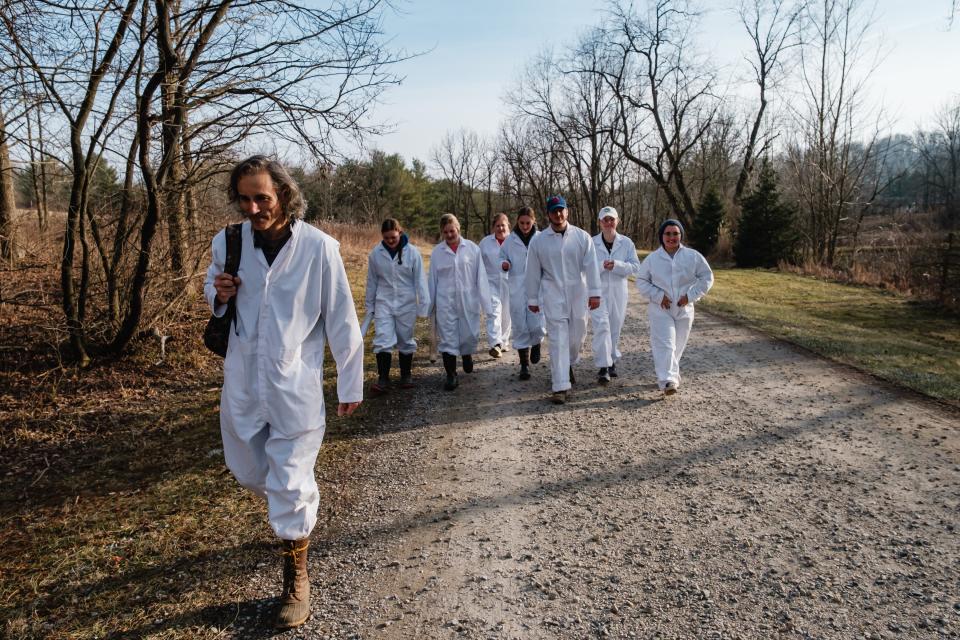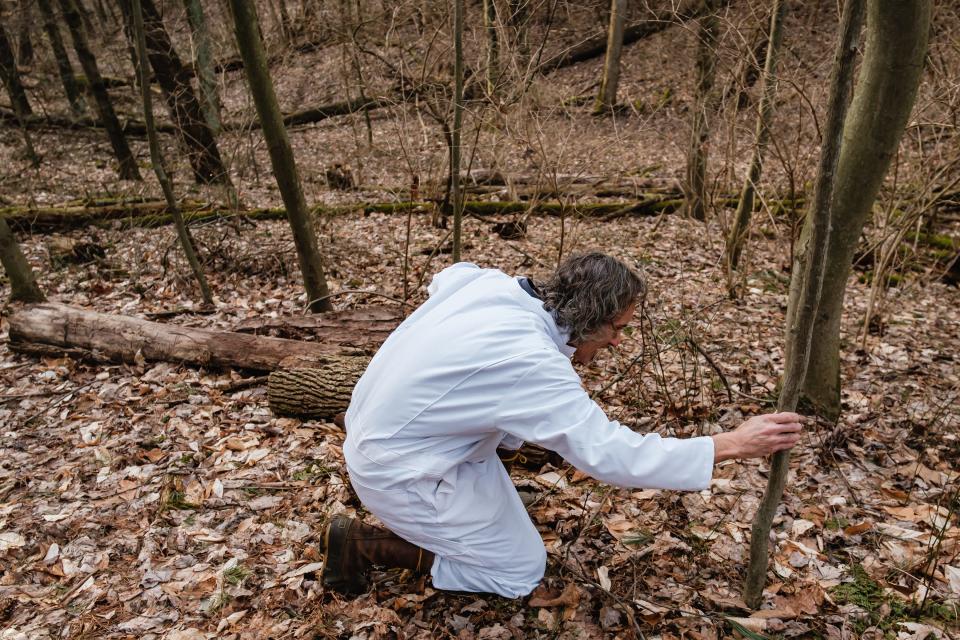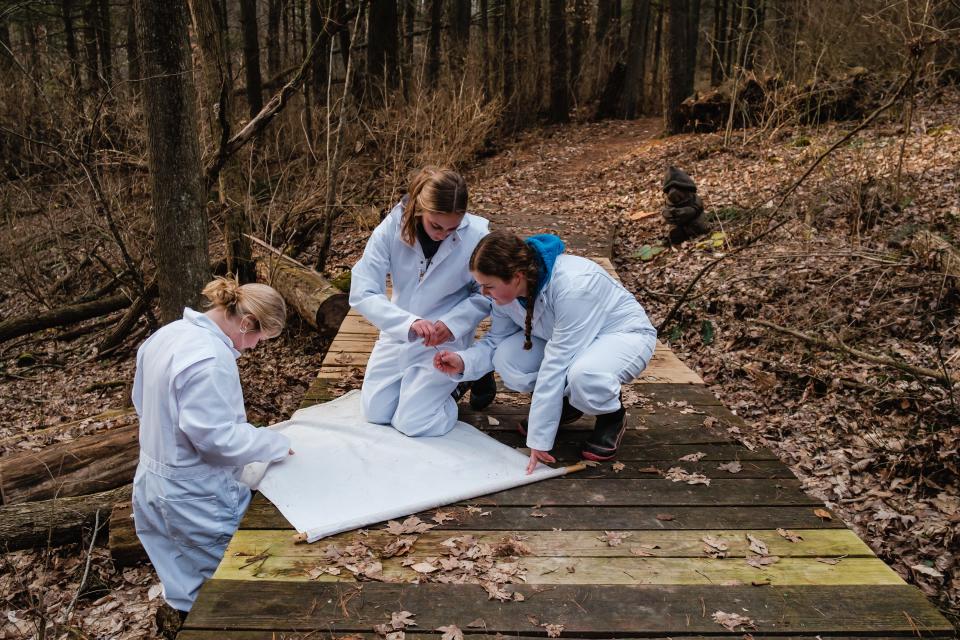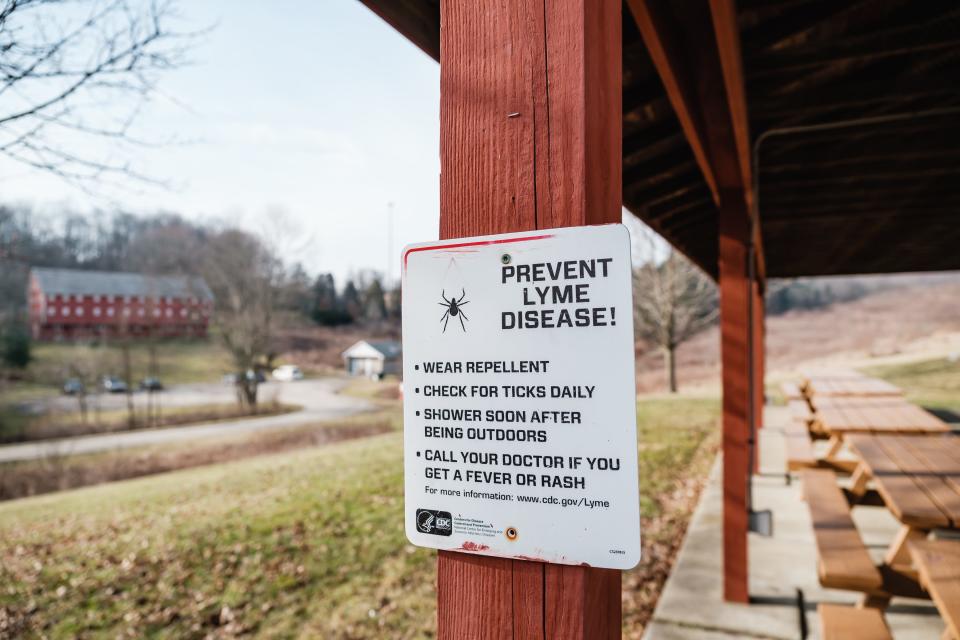Pesky prey: New Philadelphia students collect ticks for school project

DOVER TWP. ‒ Clad in white coveralls, six New Philadelphia High School students fanned out across the Norma Johnson Center looking for a pesky disease-carrying insect — the blacklegged (deer) tick.
They split into two groups, each carrying a white canvas cloth to catch the ticks, fine tweezers to remove the insects from the cloth and vials filled with alcohol to preserve them. The coveralls are designed to protect the students from tick bites.
Further information on project:New Philadelphia students target ticks in Lyme disease project
Their teacher, Kip Brady, instructed them to take 15 big steps, the equivalent of 15 meters, dragging the canvas cloth along the ground to snag the insects. The students then stopped to collect any ticks they found. Then they resumed dragging the canvas. They repeated this process eight times.
Their efforts paid off. They collected 20 ticks at two different locations at the 303-acre county-owned park west of Dover.

Once the ticks are collected, Brady and his students extract DNA from the insects to see if they carry the pathogen that causes Lyme disease.
Lyme disease is named for Lyme, Connecticut, where the disease was first identified. Typical symptoms include fever, headache, fatigue and a characteristic skin rash called erythema migrans, according to the Centers for Disease Control and Prevention (CDC). If left untreated, infection can spread to joints, the heart and the nervous system.

Doing research at the Norma Johnson Center
Brady said the Norma Johnson Center is a good place for his students to do their work.
"Because it's a public place, it's interesting to see, especially at different areas in this property, if there are differences in Lyme disease risk, tick abundance and stuff like that," he said. "So we've been surveying around different places. It also has a big mix of habitat, because of the mining history.
"It's a great place to experiment and see what things might be driving higher or lower tick abundance or disease prevalence."

Students from Brady's classes, as well as students in science classes taught by Carla Pry and Brady's wife, Jody, have been collected ticks around Tuscarawas County since the first week of October. They have been to 25 different locations.
The best time to collect ticks is when the temperature is above 40 degrees and it isn't raining.

On average, about 50% of the ticks collected test positive for Lyme disease, Brady said. There have been several locations where more than 70% have tested positive.
More than 300 ticks were collected at a location off of state Route 800 near Zoarville. The ticks weren't collected by Brady's students, but rather by members of a family with four children who live there. Five members of the family have contracted Lyme disease.
"They were like the most amazing tick collecting crew ever," he said.
The ticks have not been tested yet.

Lyme disease poses risk for both humans and dogs
"Lyme disease is a growing concern here in Tuscarawas County and in eastern Ohio as rates have been increasing over the past few years," said Jennifer Demuth, director of health promotion & community relations for the Tuscarawas County Health Department.
According to the health agency, there were 64 confirmed, suspected and probable cases of Lyme disease (in humans) in Tuscarawas County in 2020, 125 in 2021 and 149 in 2022.
Lyme disease can also pose a risk for dogs.
According to the Companion Animal Parasite Council, 3.69% of dogs tested positive for Lyme disease in Ohio, or one in 30 dogs. In Tuscarawas County, 11.33 percent of dogs tested positive, or one in eight dogs (618 total cases). Carroll County had the highest testing positivity rate in the state of Ohio: 30.73% of dogs tested positive, or one in three dogs (291 total cases).
Dogs can display several forms of Lyme disease, but the most common symptoms are lameness, swollen lymph nodes, joint swelling, fatigue and loss of appetite, according to the Animal Health Diagnostic Center at the Cornell University College of Veterinary Medicine. In addition, serious kidney complications have been associated with Lyme disease in dogs.
Warning on ticks:If you’re headed outdoors, beware of ticks

A student's view on the project
Senior Addy Kendle became involved with the project last year.
During her study hall time, she helps Brady do the process to get the ticks ready, packaging them, separating them by male and female and putting them in individual vials. She has also been involved in helping students in Pry's class learn the process that Kendle learned last year.
"This year, we've done a lot more with the field studies stuff, going out and collecting the ticks," she said. "It's kind of cool to go from start to finish on the project and seeing the hopes and dreams that Mr. Brady has for continuing it."

What are her thoughts on collecting ticks out in the field?
"I like the field work but I prefer the in-classroom genetic lab stuff," Kendle said. "I want to be a veterinarian, so that stuff is what really appeals to me and how it connects to what I want to do."
The project is funded by the Ohio Environmental Protection Agency's Ohio Environmental Education Fund. The New Philadelphia Quaker Foundation provided a grant for the coveralls, and Sawyer Products provided permethrin treatment for the coveralls.
New Philadelphia High School will be collaborating with the Tuscarawas County Park Department and the Ohio State University Cooperative Extension Service to host a program on ticks and Lyme disease on April 12 at New Philadelphia High School.
Five things to know about tick bite prevention
Know when and where to expect ticks. (Blacklegged ticks are found in the woods; dog ticks are in grassy areas and road edges.)
Use repellents according to labels.
Tuck your pants into your socks and boots and tuck your shirt into your pants.
Check yourself, family and pets regularly and remove ticks immediately.
Use anti-tick products on pets.
Source: Ohio Department of Natural Resources
This article originally appeared on The Times-Reporter: New Philadelphia students collect ticks for school project

